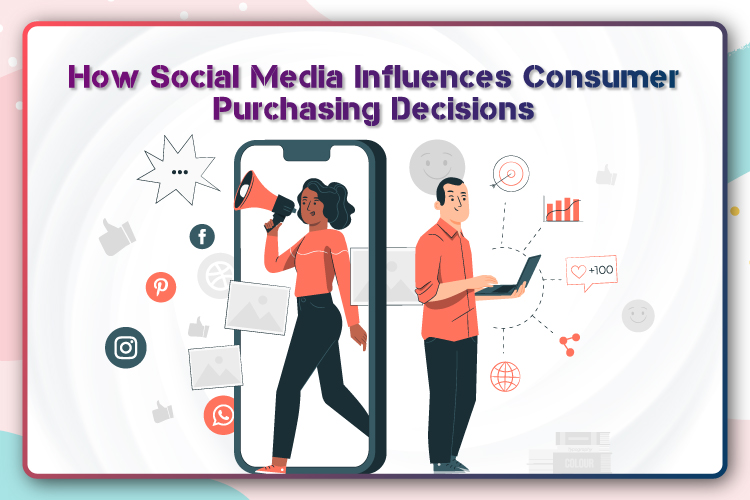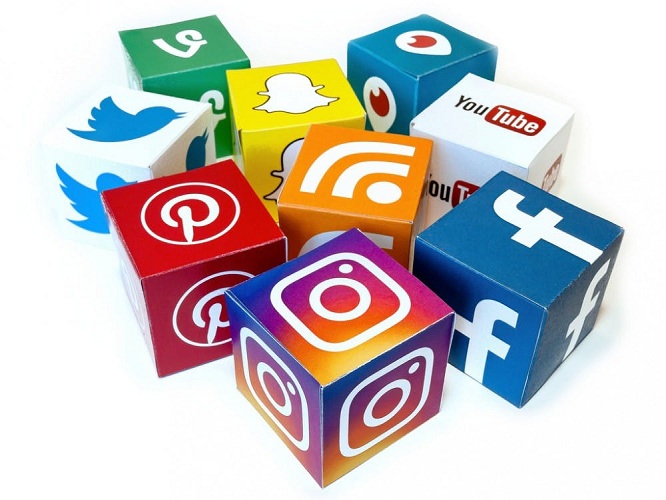How Social Media Influences Consumer Purchasing Decisions

A vast portion of product purchases is being made online today, and thanks to this pandemic for boosting this number. The number of people using the internet is increasing continuously, and at the same time, tech companies are progressively developing more new ways to merge the digital world into shopping. Thus, it is quite logical that we only expect online retail to grow exponentially in the coming times. Now reasonably, a lot of consumer purchasing decisions, too, are made online nowadays, and well where are the majority of people spending their most online time? – Social media!
As per reports, more than half of the social media users use social media platforms to research products and services. The majority of them are most likely to make a purchase based on social media referrals. In fact, if you too use social media platforms on a regular basis, then there is a very good chance that you have bought a product or service at least once because of something you saw on your feed, whether it was a friend’s or influencer’s post or a really enticing ad.
Social media not only influences what people purchase but also impacts their consumer habits as a whole. However, it is tough to say how much social networks influence consumers exactly. But social media sure brought a shift in how brands promote their products/services, and it even provided us with new advertising methods.
In this blog, we will discuss a few factors that influence consumers today.
The Impact of Social Media on Customer Purchasing Decisions
- The Shortened Customer Journey
When it comes to consumers on social media, the first point you observe is the shortened customer journey. Earlier, the process used to be like – the customer got to know about a product, viewed its ad on the television or heard it on the radio multiple times, and then maybe the next week they went out for shopping and then purchased the product at last. But now, this same time-taking process is just a matter of minutes.
According to reports, some social media users tend to buy a product on the same day they saw it on social media. Meaning as soon as they see a product they like, they click on its link and simply proceed to purchase it. Now there is no need to wait for the next week or two to go shopping and then buy something. In addition to this, most customers whose buying decisions are influenced by social media most likely spend more on shopping.
However, along with getting shorter, the customer journey has also become a bit more complicated now. With social media, users can more openly and easily research products and services. For instance, if a potential customer views your product online, they can quickly look up the hashtag to search for other reviews to make better decisions about whether or not they should purchase it. Therefore, consumers take more time to research and scan sources for more reviews from other buyers.
And well, if you are a regular social media user, then you will know how much people love sharing their opinions and personal experiences over there. In fact, the majority of social media users share their bad experiences online with other people. Therefore, it is crucial to monitor your online reputation and search for more positive social media reviews. Bear in mind that each and every review on social media matters, and the next point perfectly explains why.
- The Impact of Social Proof
Social proof certainly isn’t a new concept. Human beings are social animals, and they have been recommending things to each other for ages now. However, the only difference between then and now is that those recommendations or anti-recommendations can be seen, viewed, or listened to by thousands of other people too.
Every time you publish a tweet or a post about this incredible restaurant that has got you hooked on their delicious pasta or this great sunscreen that kept your skin protected this summer, your followers on social media see it. Maybe some of them were even enticed to try it out too. However, the same stands true for negative opinions as well. According to reports, the majority of people’s purchasing decisions are influenced by their friend’s social media posts or recommendations.
Plus, customers proactively seek recommendations on social media, and unfortunately, companies often take no notice of them. As mentioned above, social proof mainly influences your friends and acquaintances, but most social media users are not on that particular platform just to connect with people they already know – they follow influencers and content creators as well. And this is where influencer marketing comes into play.
- The “Influence” of Influencers on Consumer Purchasing Decisions
Influencers are those social media users who have a strong, loyal audience who usually shares similar interests as them. Needless to say, their opinions and recommendations are viewed by a massive audience composed of people who trust them.
Micro-influencers typically focus on a specific niche or topic where they are considered as an expert and also a natural source of recommendations for their area of focus. Thus, these influencers are particularly effective in convincing their audience, and even though the size of their audience is relatively smaller, they tend to have better, stronger relationships with them. So, if you want to sell niche products, the best way to reach your target audience is to look for a social media influencer in your niche, such as content creators, Instagram bloggers, TikTokers, vloggers, etc.
Millennials and Gen Z tend to be influenced more. The majority of millennials admitted that UGC (user-generated content) from unknown influences, to at least some level, the way they spend and purchase.
The Impact of Stories on Customer Buying Decisions
Even though ephemeral stories are a pretty recent trend, it has already taken social media by storm. Social media users, as well as brands, seem to be sold on it. While Snapchat was the one to introduce this ephemeral stories format, Instagram was the one who popularized it, and today, it enjoys 500 million+ active users every day.
Naturally, Instagram Stories lets users share more raw and unedited content, such as snippets from their daily lives, and this feature helps brands build a more authentic image. It allows businesses to show their human side to their audience, show BTS (behind-the-scenes) content, their operations, organizational culture, and the people behind their amazing products. Sharing these things with your audience helps foster an authentic relationship.
So, these were the few features of social media that influence customer buying behaviors today. But well, being a regular social media user, you must be aware of the fact that every social media platform differs from each other at some level. Considering the variety of channels available today, brands often struggle to determine which platform they must focus on. So, here we will take a quick look at some most popularly used social media networks and see what sets them apart from one another.
Most Popular Social Media Platforms

Despite having its fair share of scandals and disputes in the past few years, Facebook still continues to be the largest social media platform worldwide and boasts more than 2.5 billion monthly active users.
The platform’s enormous size indicates that businesses will naturally be able to reach more people on this network. However, you must keep in mind that Facebook is no longer as popular as it was earlier.
Youngsters have started shying away from the platform, and a decline has been observed in their platform usage while at the same time, older age group people have started using this platform more.
But even then, Facebook is responsible for half of the total social referrals. Moreover, the majority of social revenue comes from Facebook, which means the platform is still doing a pretty good job at influencing consumers’ behaviors.
Besides, the company is taking some significant measures to fix its reputation.
Instagram is an incredible social media platform for people and brands alike. It provides them with a range of opportunities to showcase their products/services – including images, videos, stories, live streaming, filters, and much more. The platform now enjoys more than a billion active users every month.
The best part about this platform is that it is popular among all generations and age groups worldwide. While the majority of platform users follow at least one business account, most youngsters agree that Instagram is the best way for companies to approach them with their new offerings and promotions.
Plus, the platform itself is introducing new features to facilitate a smooth shopping experience. Brands can add shopping tags and check out options to their posts. People are increasingly looking up for products on Instagram.
- TikTok
Even though TikTok is a comparatively new social media platform, its rapid growth has made it a vital source to increase brand awareness among social media users, mainly Gen Z.
TikTok boasts more than 800 million monthly active users globally, and almost half of these users belong to the 16-24 age group. So, if your target audience comprises teenagers and young adults, then TikTok is where you should be.
Moreover, TikTok’s algorithm is incredible when it comes to niche and specific products as the platform curates the user’s feed entirely based on their personal interests. This takes the workload of finding new followers off your shoulders by pushing your content into your potential audience’s feeds.
Plus, the platform has recently introduced new advertising methods, providing brands with better opportunities to capture potential customers on their app.
According to reports, for a lot of social media users, Twitter is the product discovery hotspot.
Twitter is quick in nature and allows its users to basically connect to anyone and everyone, which makes it an ideal place to seek recommendations. As per reports, more than half of the users recommend products or brands via tweets, while the majority of the viewers follow through to buy that particular product/service.
- YouTube
There has always been an ongoing debate on YouTube about whether it is a social media platform or only a video streaming platform. Nonetheless, it remains to be one of the most popular platforms out there.
People are increasingly searching for product reviews on YouTube. Remember that the majority of people who watched a video related to a product they wanted to purchase did so at the initial stage of their buying process. So if you are willing to put in the time and effort to build content for YouTube, it can help you reap greater rewards in the future.
Conclusion
Based on the data and our own personal experiences on the web every day, it is pretty evident that social media does influence consumer buying decisions. Many factors can easily explain social media’s impact on consumer purchasing decisions, including social proof, social media’s penetration, and online retail’s availability.
However, it’s becoming harder to differentiate your brand from others on social media. But focusing on the right channel, developing creative social media marketing campaigns, and employing the latest technologies will help make things easier for you.
Hariom Balhara is an inventive person who has been doing intensive research in particular topics and writing blogs and articles for E Global Soft Solutions. E Global Soft Solutions is a digital marketing, seo, smo, ppc and web development company that comes with massive experiences. We specialize in digital marketing, web designing and development, graphic design, and a lot more.
SOURCE : How Social Media Influences Consumer Purchasing Decisions